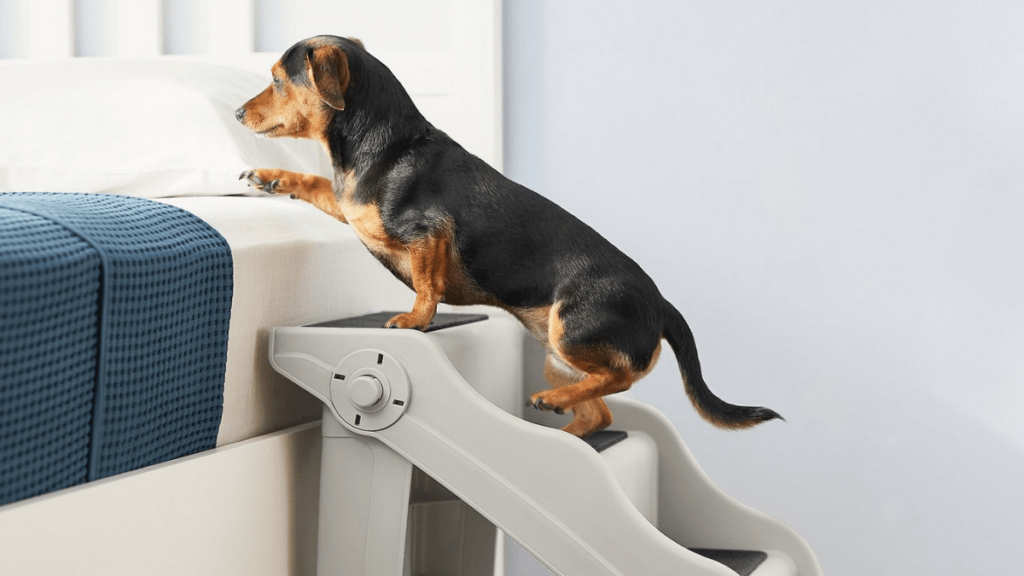“Hey honey, it’s time to go! Is all of the dog’s stuff packed and in the car?”
“Yep, I’ve got her food, beds, both the food and water bowls, her leash, some toys, a few blankets, and a bag of treats.”
“Do you think your parents will let her sleep on their bed? You know how much she loves to cuddle up with us at night!”
“I think they’d be fine with it, but honestly I don’t think she’ll be able to get up on their bed anyway. It’s pretty tall.”
What amazing pet accessory does this couple need to invest in? Any guesses? If you were thinking some pet stairs or a pet ramp, you would be correct! We know, the title of this post kind of gave it away.
Most dogs and cats don’t need pet stairs or ramps, especially those that are young and agile. There are a few canine breeds though that may benefit from some vertical assistance, and pretty much all older pets could use the help. Today we will discuss two categories of dogs who may need a “step up” and some options that could make life a little easier for them.
“Yep, I’ve got her food, beds, both the food and water bowls, her leash, some toys, a few blankets, and a bag of treats.”
“Do you think your parents will let her sleep on their bed? You know how much she loves to cuddle up with us at night!”
“I think they’d be fine with it, but honestly I don’t think she’ll be able to get up on their bed anyway. It’s pretty tall.”
What amazing pet accessory does this couple need to invest in? Any guesses? If you were thinking some pet stairs or a pet ramp, you would be correct! We know, the title of this post kind of gave it away.
Most dogs and cats don’t need pet stairs or ramps, especially those that are young and agile. There are a few canine breeds though that may benefit from some vertical assistance, and pretty much all older pets could use the help. Today we will discuss two categories of dogs who may need a “step up” and some options that could make life a little easier for them.
Small Breeds and Short Legs
Dogs with long bodies and short legs (we’re looking at you, doxies!) could benefit from a ramp or set of pet stairs at any stage of life. It can be tough to hop up on the couch when your legs are that short! A ramp or stairs offers an easier way for your adorable, vertically-challenged pup to get up on the couch for snuggle time.
Using a ramp or stairs is also a great safety measure to take with your smaller pup. Dachshunds, Basset Hounds, and Shih Tzus are all at greater risk of spinal issues. Jumping and hard landings can increase their chances of developing a herniated or slipped disc. Other small breeds can jump off the couch and land poorly, resulting in back or leg pain. Setting up a ramp or stairs provides a more comfortable and safer option for your pet when they want to use the couch or bed.
Using a ramp or stairs is also a great safety measure to take with your smaller pup. Dachshunds, Basset Hounds, and Shih Tzus are all at greater risk of spinal issues. Jumping and hard landings can increase their chances of developing a herniated or slipped disc. Other small breeds can jump off the couch and land poorly, resulting in back or leg pain. Setting up a ramp or stairs provides a more comfortable and safer option for your pet when they want to use the couch or bed.
Older Pets of All Sizes
As pet parents, we do our very best to keep our dogs happy and healthy as they age. We have to be at the top of our game as our furry family members grow into senior hood, as physically issues like arthritis become practically inevitable in the later stages of life. If you notice that your senior pup is experiencing discomfort while walking or playing, or just doesn’t seem interested in hopping up on the bed anymore, some vertical assistance may be in order. Ramps are also great when you need to get a large old dog into the car (but you don’t need this because your vet comes to the home, right? *wink wink*)
We absolutely encourage you to have a discussion with your vet if you think your pet has arthritis or any type of mobility issues. There are so many options available to our pets to address joint health, mobility, and pain, and your vet can help you come up with a treatment/management plan that works for your lifestyle and budget.
We absolutely encourage you to have a discussion with your vet if you think your pet has arthritis or any type of mobility issues. There are so many options available to our pets to address joint health, mobility, and pain, and your vet can help you come up with a treatment/management plan that works for your lifestyle and budget.
I think my dog needs a ramp...where do I get one?
Enter Google, stage right! No kidding; a quick search on Google will bring up hundreds of shopping choices. There are dozens of ramp and stairs styles available, with a variety of features and price ranges. Some ramps can adjust for height or fold down for storage. Many come in more “stylish” finishes, in case you’re looking for a more polished look. Some ramps and stairs are specific for indoor use, whereas others are designed to help pets get into vehicles.
When picking out a ramp or set of stairs, you may want to consider the following:
As you shop for ramps, try finding one with a low, gentle incline and make sure the width is adequate for your pet’s size. This is especially important for senior dogs, who may have trouble getting up a steep ramp. Surface texture is another point to consider, as your pet will need traction to get up! Rubber matting or indoor/outdoor carpet are grippy surface options that are also easy to clean.
If you think stairs are a better option for your pet, make sure you find a set that is stable, with a deeper run and lower rise. Just like with ramps, you’ll want to make sure that the stairs have a non-slip surface.
When picking out a ramp or set of stairs, you may want to consider the following:
- Where does the ramp or stairs need to be placed?
- Do you need a portable option, or will it remain in the same place?
- How large is your pet, and your living space? Ramps and stairs come in several sizes.
- How high up does my pet need to go? You’ll need to make sure that the item you purchase is high enough for your furniture or vehicle.
- How heavy is your pet? Make sure that the ramp or stairs can support your pet’s weight.
As you shop for ramps, try finding one with a low, gentle incline and make sure the width is adequate for your pet’s size. This is especially important for senior dogs, who may have trouble getting up a steep ramp. Surface texture is another point to consider, as your pet will need traction to get up! Rubber matting or indoor/outdoor carpet are grippy surface options that are also easy to clean.
If you think stairs are a better option for your pet, make sure you find a set that is stable, with a deeper run and lower rise. Just like with ramps, you’ll want to make sure that the stairs have a non-slip surface.
Speaking of non-slip surfaces...
If you have a senior dog with mobility issues, a special needs dog, or a breed that is at higher risk of physical injury, you can further enhance their safety and comfort around the home with a few easy solutions. If you have slippery stairs, try placing non-slip carpet runners on each stair so that your pet has an easier time going up and down. If you have wood, tile, or other types of flooring that can be more slick, consider adding yoga mats or carpet runners to hallways and in areas where your pet spends lots of time. Dog socks (if your pup will tolerate them!) with grips on the soles, or adhesive paw pad grips, are another option. These may take some time for your pup to get used to.
Weekly paw maintenance can also go a long way towards improving stability and balance, and we recommend that you keep your dog’s nails and pad hair trimmed. Long nails can affect your dog’s ability to gain traction on wood, tile, vinyl, or cement floors. Fur can also grow in between paw pads, and when this gets long enough it can reduce your pup’s ability to grip.
Weekly paw maintenance can also go a long way towards improving stability and balance, and we recommend that you keep your dog’s nails and pad hair trimmed. Long nails can affect your dog’s ability to gain traction on wood, tile, vinyl, or cement floors. Fur can also grow in between paw pads, and when this gets long enough it can reduce your pup’s ability to grip.






